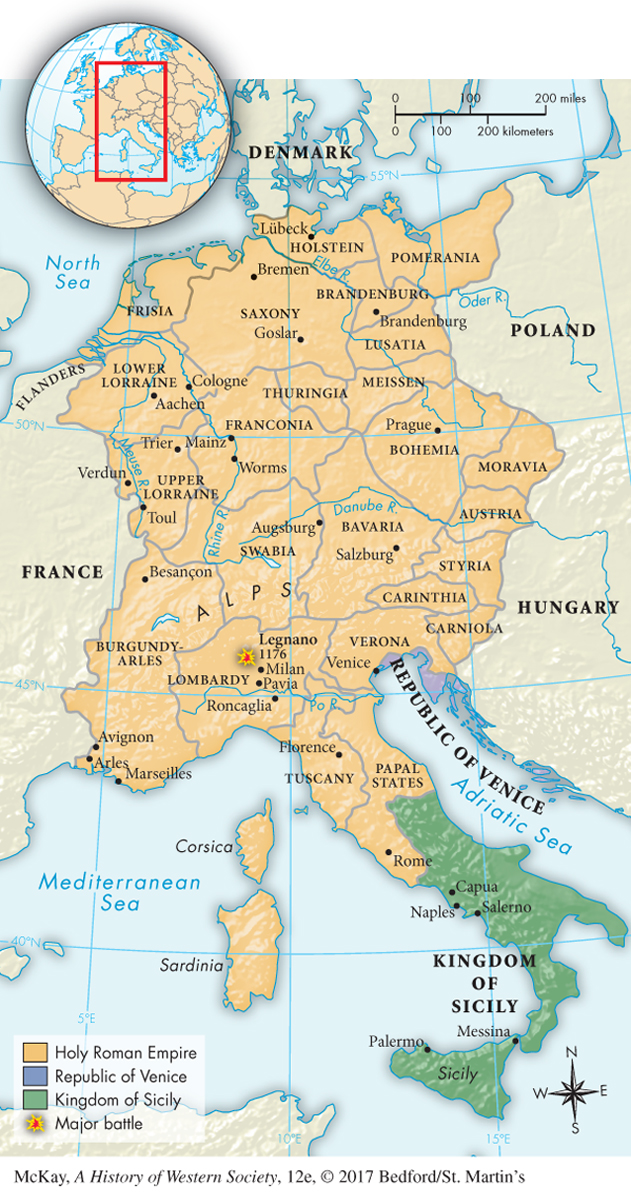A History of Western Society: Printed Page 254
A History of Western Society, Value Edition: Printed Page 240
A History of Western Society, Concise Edition: Printed Page 256
Central Europe
In central Europe the German king Otto I (r. 936–973) defeated many other lords to build his power from his original base in Saxony. Some of our knowledge of Otto derives from The Deeds of Otto, a history of his reign in heroic verse written by a nun, Hroswitha of Gandersheim (ca. 935–ca. 1003). Hroswitha viewed Otto’s victories as part of God’s plan: “As often as he set out for war, there was not a people, though haughty because of its strength, that could harm or conquer him, supported as he was by the consolation of the heavenly King.”2
Otto garnered financial support from church leaders and also asserted the right to control ecclesiastical appointments. Before receiving religious consecration and being invested with the staff and ring symbolic of their offices, bishops and abbots had to perform feudal homage for the lands that accompanied the church office. This practice, later known as “lay investiture,” created a grave crisis between the church and the monarchy in the eleventh century (see “Emperor Versus Pope”).
In 955 Otto I inflicted a crushing defeat on the Magyars in the Battle of Lechfeld (see Chapter 8), which made Otto a great hero to the Germans. In 962 he used this victory to have himself crowned emperor by the pope in Aachen, which had been the capital of the Carolingian Empire. He chose this site to symbolize his intention to continue the tradition of Charlemagne and to demonstrate papal support for his rule. Though it was not exactly clear what Otto was the emperor of, by the eleventh century people were increasingly using the term Holy Roman Empire to refer to a loose confederation of principalities, duchies, cities, bishoprics, and other types of regional governments stretching from Denmark to Rome and from Burgundy to Poland (Map 9.2).

In this large area of central Europe and northern Italy, the Holy Roman emperors shared power with princes, dukes, archbishops, counts, bishops, abbots, and cities. The office of emperor remained an elected one, though the electors numbered seven — four secular rulers of large territories within the empire and three archbishops.
None of Otto’s successors were as forceful as he had been, and by the first half of the twelfth century civil wars wracked the empire. The electors decided the only alternative to continued chaos was the selection of a strong ruler. They chose Frederick Barbarossa of the house of Hohenstaufen (HOH-
Between 1154 and 1188 Frederick made six military expeditions into Italy in an effort to assert his imperial rights over the increasingly wealthy towns of northern Italy. While he initially made significant conquests, the Italian cities formed leagues to oppose him, and also allied with the papacy. In 1176 Frederick suffered a crushing defeat at Legnano, where the league armies took massive amounts of booty and many prisoners (see Map 9.2). This battle marked the first time a cavalry of armed knights was decisively defeated by an army largely made of infantrymen from the cities. Frederick was forced to recognize the municipal autonomy of the northern Italian cities and the pope’s sovereignty in central Italy. His campaigns in Italy took him away from the parts of the empire north of the Alps, and regional rulers there reasserted their authority toward the end of Frederick’s reign and in the reigns of his successors. Thus, in contrast to France and England, Germany did not become a unified state in the Middle Ages, and would not until the nineteenth century.